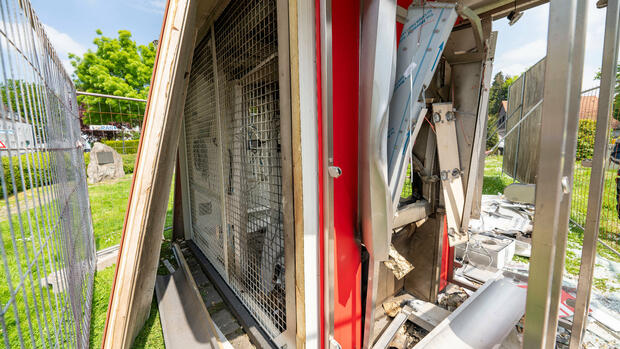In 2022, almost 500 ATMs in Germany were blown up, more than ever before.
(Photo: IMAGO/Jochen Tack)
Frankfurt The first savings banks and Volksbanks are considering using the adhesive technology to protect against ATM blasts. They contacted the manufacturer of the systems, the Dutch company Mactwin Security. “We have dozens of inquiries from German banks and are now in contact with several savings banks and Volksbanks,” Mactwin technical director Robin Bijland told the Handelsblatt.
In 2022, almost 500 ATMs in Germany were blown up, more than ever before. By the beginning of May this year, there had already been almost 120 attacks on ATMs in North Rhine-Westphalia, Hesse, Rhineland-Palatinate, Lower Saxony and Baden-Württemberg. Mostly they are perpetrated by perpetrators from the Netherlands. The previous protective measures did not adequately prevent the explosions.
>>Read here: At least one ATM is blown up every day
The Bundesbank recently gave the green light for the new defense technology. In the event of a machine explosion, the banknotes stick together in a lump and can no longer be used and usually no longer counted.
The German Savings Banks and Giro Association has already announced that its member institutes also want to use the adhesive systems in the future. “The savings banks will use the bonding technology as soon as possible at the locations where it makes sense,” DSGV board member Joachim Schmalzl told the Handelsblatt a few days ago.
In the Netherlands, the gluing technique is considered a successful defensive measure. The number of explosions there has fallen sharply. According to the Dutch Bankers Association, it fell from 129 in 2013 to nine last year.
Discussions with banks and accident insurers
According to Mactwin, it has produced around 1,500 gluing systems under the product name “Gluefusion” for the Dutch market. 1200 to 1500 of them are in operation. According to the Dutch central bank, there were almost 5,000 ATMs in the Netherlands at the end of 2021. In Germany there were about ten times as many recently. Bijland quoted EUR 5,000 to 6,000 per machine as the cost of the adhesive system. He also estimates 500 to 1000 euros for the installation.
The company is talking to banks, the GDV insurance association and, since the beginning of the year, the VdS security inspection agency about the necessary certification, said the Mactwin manager. Since this is a completely new product in Germany, the certification should take some time.
In addition to the certification, the adhesive system must also be assessed in terms of occupational health and safety. The installation of the protection system is considered potentially dangerous – for example in the event that it is accidentally activated. Mactwin is in talks on this subject with accident insurers, specifically with the Central Association of German Statutory Accident Insurance (DGUV). When asked by the Handelsblatt, the association said it was still waiting for the manufacturer to reply.
>>Read here: Interior ministers are threatening banks with binding protective regulations
Many banks are now closing ATM locations at night, and the first have branches guarded by security personnel. They also often use video transmission systems, demolition and shake detectors, special security systems for windows and access doors, fogging technology and systems that discolour banknotes in the event of an explosion. This does not seem to bother the perpetrators: they also take discolored banknotes with them.
The financial industry rejects a legal regulation on protective measures, such as those considered by the federal states and the federal government. There is already an agreement on voluntary steps.
DSGV board member Schmalzl warned against high expectations. “The bonding technique will not completely solve the problem of ATM demolitions. It’s not a panacea.” One has to assume that the perpetrators would not be completely deterred by this and would react with new, even more aggressive methods – “possibly also in the hope that not all the banknotes will be completely glued together,” he said.
More: Better protection for ATMs
